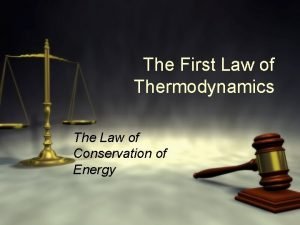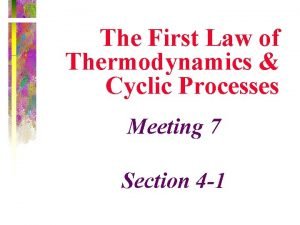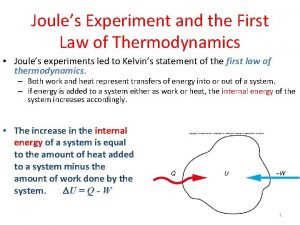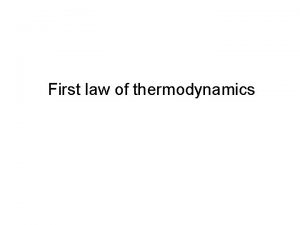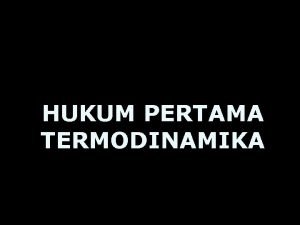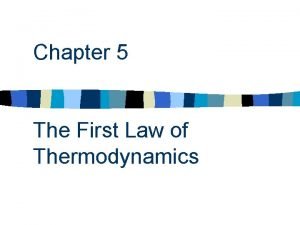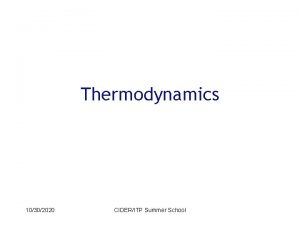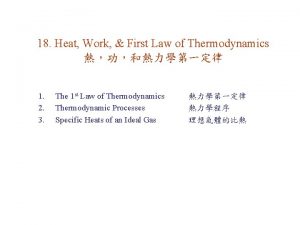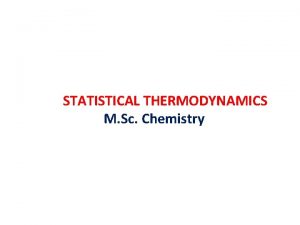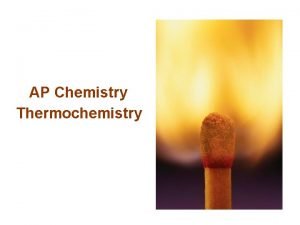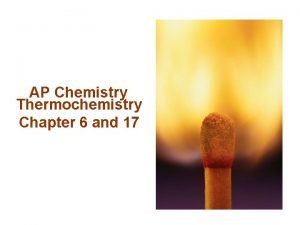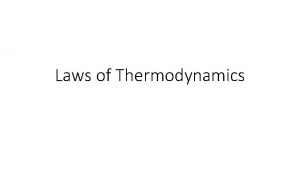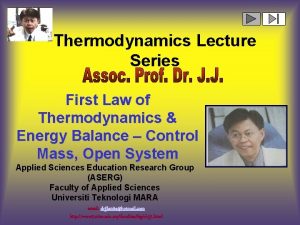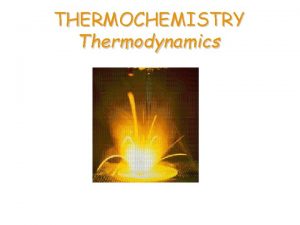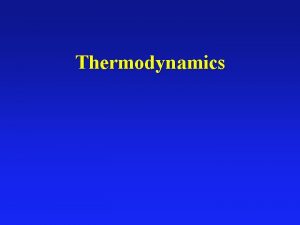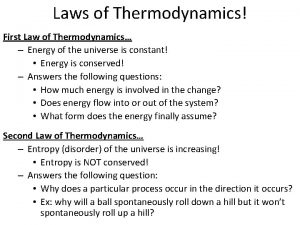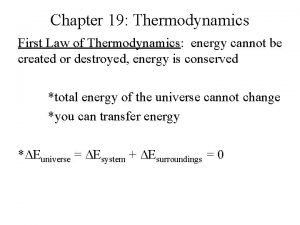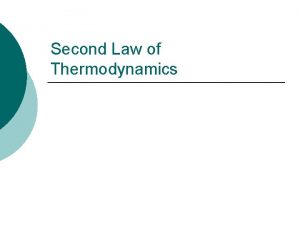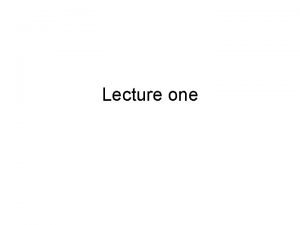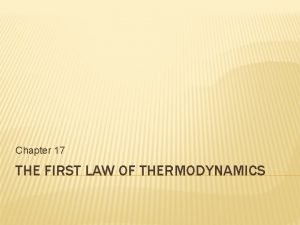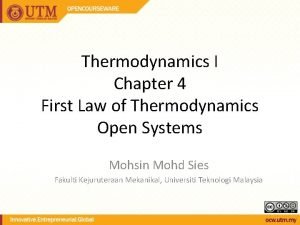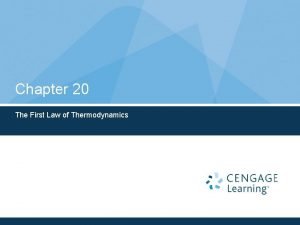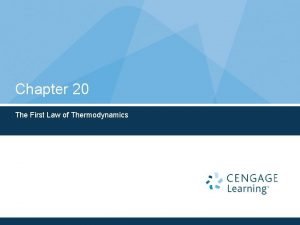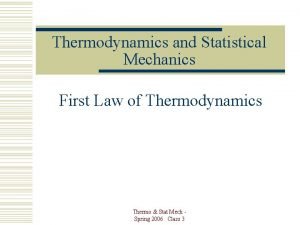First Law of Thermodynamics College Chemistry Energy Many

















- Slides: 17

First Law of Thermodynamics College Chemistry

Energy �Many types of energy must obey law of conservation of energy �Energy cannot be created or destroyed, it can only change forms �energy – capacity to do work �Work = Force x distance �Kinetic energy, potential energy, radiant (solar) energy, thermal energy (heat), chemical energy (stored in bonds)

Systems & Surroundings In thermodynamics, the world is divided into a system and its surroundings A system is the part of the world we want to study (e. g. a reaction mixture in a flask) The surroundings consist of everything else outside the system SYSTEM OPEN ISOLATED CLOSED

OPEN SYSTEM: can exchange both matter and energy with the surroundings (e. g. open reaction flask, rocket engine) CLOSED SYSTEM: can exchange only energy with the surroundings (matter remains fixed) e. g. a sealed reaction flask ISOLATED SYSTEM: can exchange neither energy nor matter with its surroundings (e. g. a thermos flask)

EXOTHERMIC & ENDOTHERMIC REACTIONS Exothermic process: a change (e. g. a chemical reaction) that releases heat. Exothermic process: heat < 0 (at constant pressure) Burning fossil fuels is an exothermic reaction

Endothermic process: a change (e. g. a chemical reaction) that requires (or absorbs) heat. Endothermic process: heat > 0 (at constant pressure) Photosynthesis is an endothermic reaction (requires energy input from sun) Forming Na+ and Cl- ions from Na. Cl is an endothermic process

Measuring Heat reaction Exothermic reaction, heat given off & temperature of water rises Endothermic reaction, heat taken in & temperature of water drops


Thermodynamics �Thermodynamics – scientific study of the interconversions of heat and energy �Thermochemistry is a state function �Thermochem depends only on where you started and where you ended, does NOT matter how you get there

First Law of Thermodynamics �Conservation of energy, energy cannot be created or destroyed but only change forms �DE = Ef – Ei �If we consider a reaction, we can consider the products and the reactants �S(s) + O 2(g) SO 2(g) �DE = Eproducts - Ereactants �Also, since we know that energy must be conserved, the energy lost (or gained) by the system (the reaction), must be equal to the energy gained (or lost) by the surroundings � 0 = DEsystem + DEsurrounding OR DEsys = - DEsurr

The First Law of Thermodynamics • • • Relating DE to Heat(q) and Work(w) Energy cannot be created or destroyed. Energy of (system + surroundings) is constant. Any energy transferred from a system must be transferred to the surroundings (and vice versa). We normally don’t care about the surroundings, we just care about the work done (or by) the surroundings on the system From the first law of thermodynamics:

The First Law of Thermodynamics

First Law of Thermodynamics �Calculate the energy change for a system undergoing an exothermic process in which 15. 4 k. J of heat flows and where 6. 3 k. J of work is done on the system. �Work/energy/heat (q) is almost ALWAYS given in Joules (or k. J), sometimes calories DE = q + w


Work and Heat �The concept of work can be applied to gases �Pistons move gases up and down �If gases are expanded – work is negative �If gases contrast – work is positive �Work done on gases is in atm (usually), we need a conversion factor to convert to Joules � 1 L*atm = 101. 3 J

Example 6. 1 � A certain gas expands in volume from 2. 0 L to 6. 0 L at constant temperature. Calculate the work done by the gas if it expands (a) against a vacuum and (b) against a constant pressure of 1. 2 atm � (a) w = -PDV �w = -(0 atm)(6 – 2 L) = 0 J �No work done � (b) w = -PDV �w = -(1. 2 atm) (6. 0 – 2. 0 L) = -4. 8 L*atm �-4. 8 L*atm x (101. 3 J/1 L*atm) = -4. 9 x 102 J �Work is negative, gas expanded � This example shows work (or heat) is NOT a state function, beginning and ending volume are the same, but the external pressure affects it

Example 6. 2 �The work done when a gas is compressed in a cylinder is 462 J. During this process, there is a heat transfer of 128 J from the gas to the surroundings. Calculate the energy for this process. �DE = q + w - 128 J (exothermic) �w = + 462 J (compressed) �q = �YOU MUST FIRST ALWAYS FIND THE SIGNS! �Now plug it in �DE = -128 J + 462 J = 334 J
 Newtons third law of thermodynamics
Newtons third law of thermodynamics First law of thermodynamics open system
First law of thermodynamics open system Isobaric process formula
Isobaric process formula First law of thermodynamics for cyclic process
First law of thermodynamics for cyclic process First law of thermodynamics experiment
First law of thermodynamics experiment Quasi static process
Quasi static process Steady flow process in thermodynamics
Steady flow process in thermodynamics First law of thermodynamics sign convention
First law of thermodynamics sign convention Enthalpy vs internal energy
Enthalpy vs internal energy Free energy
Free energy Thermodynamics of ideal gases
Thermodynamics of ideal gases Newton's first law and second law and third law
Newton's first law and second law and third law Si unit of newton's first law
Si unit of newton's first law Statistical thermodynamics is a study of
Statistical thermodynamics is a study of 11th chemistry thermodynamics lec 13
11th chemistry thermodynamics lec 13 Ap chemistry thermodynamics
Ap chemistry thermodynamics Thermodynamics ap chemistry
Thermodynamics ap chemistry 11th chemistry thermodynamics lec 10
11th chemistry thermodynamics lec 10


